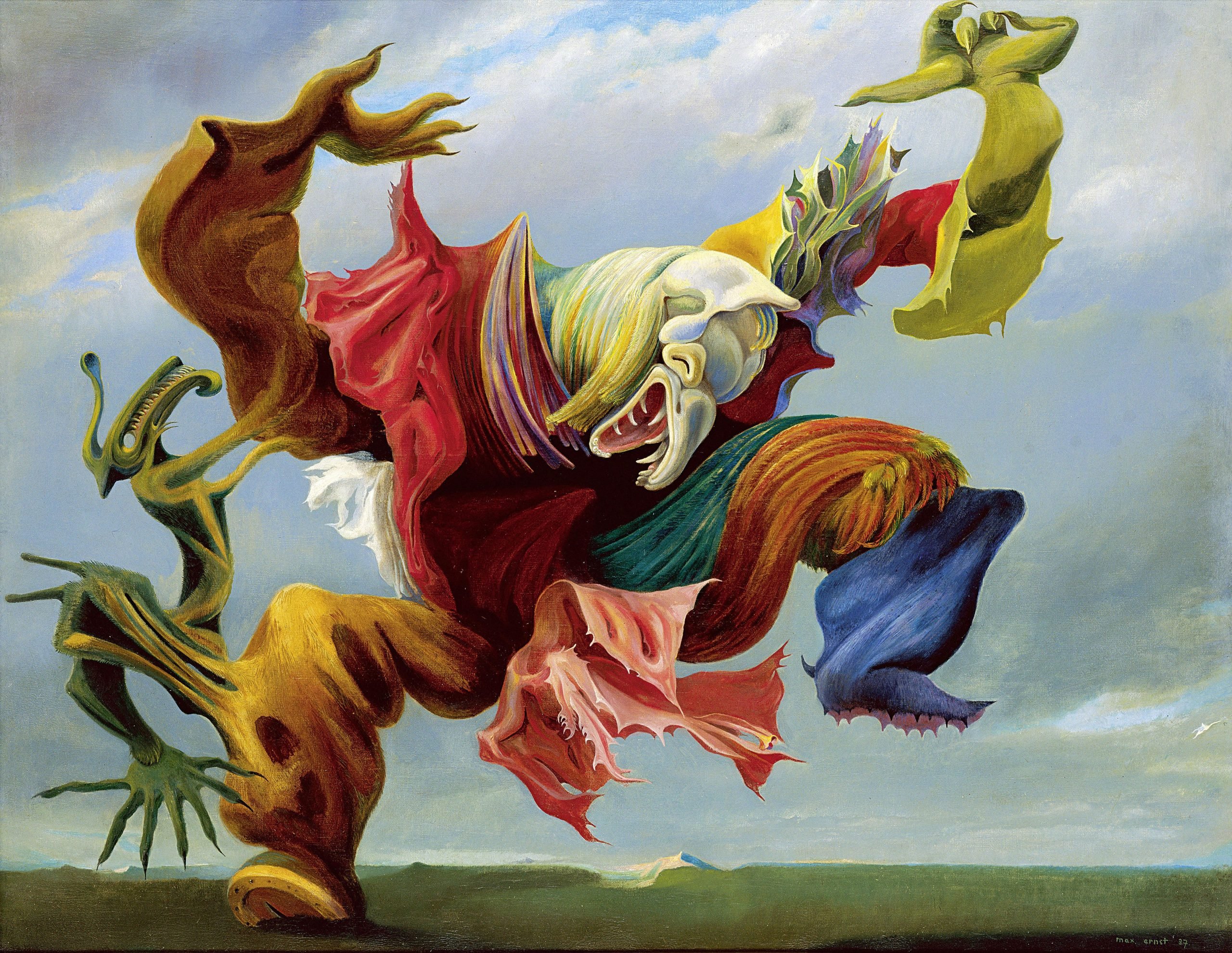
Lobster telephones, raining men in gray suits and bowler hats, and the stuff of unconscious dreams, are some imagery that automatically come to mind with Surrealism. But what more is there to understand about these works and their makers? The Surrealist movement spans a vast breadth of artistic creation, not limited to the visual realm, with its roots reaching into the Middle Ages and branching into today’s artistic languages. Now, as it celebrates its centennial anniversary, a slew of international exhibitions are delving into new and lesser-known aspects of Surrealism, from large, heavily researched surveys including well-known and varied figures, to examinations of overlooked participants, curators are asking what Surrealism has to tell us today.
Below, find five exhibitions that answer the question with gusto.
“Imagine! 100 Years of International Surrealism”
until July 21, 2024
Royal Museums of Fine Arts of Belgium, Brussels
Max Ernst, Attirement of the Bride (1940), Collezione Peggy Guggenheim, Venezia (Fondazione Solomon R. Guggenheim, New York) © Sabam Belgium, 2024
This blockbuster exhibit is one of the most extensive projects marking the centennial celebration and includes some 30 major artworks loaned by the Centre Pompidou. The exhibition will subsequently travel to four international museums and each iteration will be unique, with museums emphasizing different aspects of the movement, often by drawing connections to local heritage. The Brussels edition takes a fresh look at the movement’s origins within Symbolism via nearly 140 paintings, works on paper, sculptures, photographs, and other objects by a broad range of artists, from Salvador Dalí, Giorgio de Chirico, Max Ernst, Leonor Fini, Dora Maar, Man Ray, to Dorothea Tanning.
“Imagine! 100 Years of International Surrealism” will travel to the Centre Pompidou in Paris, September 4–January 13, 2025; Hamburger Kunsthalle, Hamburg, June 12, 2025 – Oct. 12, 2025; Fundación Mapfré, Madrid, February 4, 2025–May 11, 2025; Philadelphia Museum of Art, autumn 2025–spring 2026]
“Surrealism and Us: Caribbean and African Diasporic Artists since 1940”
until July 25, 2024
The Modern, in Fort Worth, Texas
Bony Ramirez, Clean Up, After the Storm, (2020) 60 × 40 in. (152.4 × 101.6 cm) Acrylic, colored pencil, oil pastel, wallpaper, gold leaf marker, plastic pearls, Bristol paper on wood. Private Collection© Bony Ramirez, photo courtesy Dawn Blackman
This unique exhibit curated by María Elena Ortiz, looks at the history of Surrealism in the Caribbean and notions of the Afrosurreal in the US. Inspired by the essay, “1943: Surrealism and Us,” by Suzanne Césaire, the show includes some 80 artworks made in the 1940s up to the present day, in a range of media that explore how Caribbean and Black artists have interpreted and appropriated the avant-garde movement. Artists include Nick Cave, Augustinín Cárdenas, Aimé Césaire, Myrlande Constant, Luis Maisonet Crespo, Hector Hyppolite, Simone Leigh, Kenny Rivero, Kara Walker, and Cossette Zeno, to name a few.
“But Live Here? No Thanks: Surrealism and Anti-Fascism”
October 15, 2024—March 2, 2025
Städtische Galerie, Lenbachhaus, Munich
Ted Joans and Jean-Jacques Lebel in New York in 1961, with a “bomb” that was to be transformed into a sculpture © Jean-Jacques Lebel, VG-Bild-Kunst, Bonn 2024
“The human soul is international,” reads a Surrealist bulletin published in Prague in 1935. In light of our current, fraught times, this show offers a pertinent perspective on the anti-fascist, political aspects of the movement. From denouncing colonialism, organizing resistance to fascist powers, and calling for sabotage within Nazi ranks, to being detained and persecuted, Surrealists faced and were forced to respond to the upheavals surrounding the Second World War. The exhibition takes a non-linear, broader approach to defining the international movement, featuring multi-media works by artists such as Manuel and Lola Alvarez Bravo, Georges Bataille, Victor Brauner, Claude Cahun and Marcel Moore, Leonora Carrington, Aimé Césaire, Suzanne Césaire, Oscar Dominguez, Robert Desnos, Wilfredo Lam, André Masson, Roberto Matta, Lee Miller, Joan Miró, Yves Tanguy, and more.
“The Traumatic Surreal”
November 22, 2024—March 16, 2025
Henry Moore Institute, Leeds
Bady Minck, still from La Belle est la Bête (2005) © Bady Minck, AUT/LUX/NED 2005, sixpackfilm
This exhibition focuses on radical post-war women artists in Germany, Austria, Switzerland, and Luxembourg. It is built around the book The Traumatic Surreal by Professor Patricia Allmer, who co-curated the exhibit. Works by artists such as Renate Bertlmann, Birgit Jürgenssen, Bady Minck, Meret Oppenheim, Pipilotti Rist, Ursula (Schultze-Bluhm), and Eva Wipf use a variety of found objects, collages, and assemblage to probe the legacy of fascism, Nazism, and the impact both have had on womanhood. These artists have effectively been “redefining and reconfiguring surrealism in new directions,” states the exhibition text.
Nearby in Yorkshire’s The Hepworth Wakefield, another Surrealism show is programmed to open concurrently. Titled “Forbidden Territories: 100 Years of Surreal Landscapes,” open from November 23, 2024, to April 27, 2025, and will look at how Surrealism explores landscape as a metaphor for the unconscious, fusing bodies with the botanical.
“Gertrude Abercrombie: The Whole World is a Mystery”
January 18, 2025 to June 1, 2025
Carnegie Museum of Art in Pittsburgh, Pennsylvania
Gertrude Abercrombie, Search for Rest (1951). Collection of Sandra and Bram Dijkstra. Photo: Sandy and Bram Dijkstra.
This solo show is the most comprehensive museum presentation of the historically overlooked artworks by Gertrude Abercrombie (1909–1977), co-organized by the Carnegie Museum of Art and Colby College Museum of Art. The so-called American “jazz witch” artist was a key figure in the Chicago art scene in her time and was particularly close to jazz musicians like Charlie Parker and Dizzy Gillespie. She hosted many of them in her ramshackle house, and they were among the greatest early admirers of her potent but restrained Surrealist paintings of desolate landscapes featuring cats, playing cards, self-portraits, and moons.